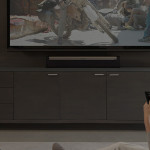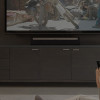
San Diego Home Entertainment Systems
How Big Should Your Screen Be?
When people buy televisions or theater screens for their home entertainment system, they tend to simply want the biggest possible screen. They are under the often mistaken impression that indeed bigger is better, if not best.
They are probably thinking that the bigger the screen is, the greater the impact and the more lifelike the TV show or video on the screen is. This is certainly true to an extent, but it’s far from being the whole truth and there are a lot more things to consider in your home entertainment system. 
We tend to think that bigger is not always better, especially if the size of the room will put you too close to the TV. For instance, if you have a small media room, and you have a couch or another form of seating close to where your TV is going to be set up, too big can sometimes be too much. Or perhaps a TV that is at the foot of your bed. Granted, this is usually not the case especially since the advent of 4K TV where the picture quality is so spectacular.
Screen size is even more important if you are planning a home theater with a separate screen and projector in your home entertainment system. In this application it is even more likely that folks would have the “bigger is better” attitude. But this is precisely the situation where the greatest care is required. You can’t just measure the space and pick the largest screen that will fit on the wall. Particularly in a dedicated home theater, it is important to make sure the screen is at a height where everyone in the theater can see it.
For instance, if the room has two or more rows, the height of the screen off the floor becomes a critical consideration. You don’t want someone sitting in the second or back row not be able to see the bottom of the screen because it is being blocked by someone sitting in front of them. If this happens, your screen is either too big or needs to be up higher on the wall. But if it needs to be raised you have to be careful that someone sitting in the first row, who is closer to the screen, won’t be looking up at the image which could cause neck strain. This gets us into the whole topic of home theater sight lines and screen shape – but that’s a blog for another day…
home entertainment systems

